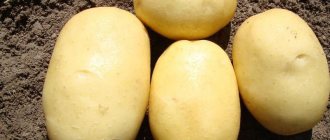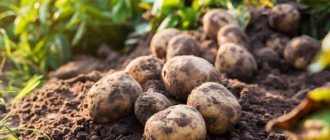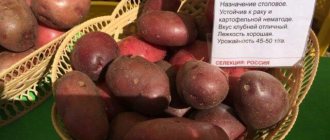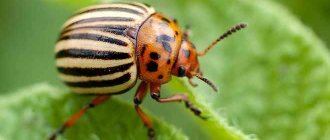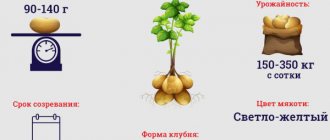Description of the variety and its origin
Mid-season Tuscany potatoes are a variety of German selection. Bred by biologists of the famous company Solana. It is not included in the State Register of Russia due to the lack of necessary research. The crop is suitable for cultivation in any region of the country.
The photo shows Tuscany potatoes.
The table summarizes the distinctive features of the variety.
| Indicators | Characteristic |
| Ripening period | 70–90 days |
| Bush | Medium height, semi-erect, heavily leafy |
| Number of tubers in a bush | 7–11 |
| Weight | 90–125 |
| Form | Oval-round |
| Coloring | The peel and pulp are yellow, the eyes are small |
| Leaves | Small, green in color, with slight wavy edges |
| Corolla color | White |
| Starch content | 12–14% |
| Taste | Excellent (5 on a five-point scale) |
| Cooking class/group | A (slightly boiled) |
| Productivity | 210–460 c/ha |
| Marketability | 97% |
| Keeping quality | 93% |
| Purpose | Dining room |
| Sustainability | To golden nematode, crayfish, common scab, blackleg, rhizoctonia |
| Transportability | High |
Chemical composition
The table shows the complex of vitamins and minerals contained in 100 g of raw tubers.
| Name | Content | Norm |
| Beta carotene | 0.001 mg | 5 mg |
| Vitamin B1 | 0.081 mg | 1.5 mg |
| Vitamin B2 | 0.032 mg | 1.8 mg |
| Vitamin B4 | 12.1 mg | 500 mg |
| Vitamin B5 | 0.295 mg | 5 mg |
| Vitamin B6 | 0.298 mg | 2 mg |
| Vitamin B9 | 15 mcg | 400 mcg |
| Vitamin C | 19.7 mg | 90 mg |
| Vitamin E | 0.01 mg | 15 mg |
| Vitamin K | 2 mcg | 120 mcg |
| Vitamin PP | 1.061 mg | 20 mg |
| Potassium | 425 mg | 2500 mg |
| Calcium | 12 mg | 1000 mg |
| Magnesium | 23 mg | 400 mg |
| Sodium | 6 mg | 1300 mg |
| Phosphorus | 57 mg | 800 mg |
| Iron | 0.81 mg | 18 mg |
| Manganese | 0.153 mg | 2 mg |
| Copper | 110 mcg | 1000 mcg |
| Selenium | 0.4 mcg | 55 mcg |
| Zinc | 0.3 mg | 12 mg |
Origin
The Tuscany potato variety was bred by German breeders. The originator is Solana, a company specializing in the production of promising vegetable hybrids.
The variety is recommended for industrial or amateur cultivation; the tubers can be planted on any soil , in regions with a temperate, continental, or sharply continental climate. Potatoes are suitable for sale, production of semi-finished products (frozen French fries, soup mixes, chips).
We bring to your attention other high-yielding potato varieties presented on our website: Jewel, Tiras, Lugovskoy, Irbitsky, Vesna, Arosa, Timo, Bellarosa, Kubanka, Innovator, Lileya, Triumph, Colombo, Rocco, Lilac Tuman, Smuglyanka, Nevsky.
Potato agricultural technology
Tuscany potatoes are undemanding to soil composition and adapt to any cultivation conditions. The agricultural technology of the crop is simple, it provides for timely watering during the dry period, loosening the earthen crust, removing weeds, hilling and fertilizing with organic matter and minerals.
Tuber preparation
Due to the short dormant period, the tubers do not need to be germinated before planting. It is enough to take the seeds outside from storage 3–5 days before planting, rinse with running water, treat with a solution of boric acid, copper sulfate or potassium permanganate and dry. 24 hours before planting, the tubers are soaked in a growth stimulator (Epin, Zircon).
To be on the safe side, seed material is subjected to vernalization. 20 days before planting, the tubers are washed, disinfected, placed in boxes with holes and left in a warm room with a temperature of +14...+17°C.
Soil preparation
As practice shows, potatoes prefer light and nutritious soil: sandy loam, sandy, peat. Cultivation on loam is possible provided humus is added.
In the fall, the plot is dug up, harrowed, fertilized, and in the spring it is sown with oats, lupine, rye, flax, and wheat. After a month, the mowing is buried in the soil to enrich it with nitrogen and prevent the development of pathogenic microflora.
Dates, scheme and rules of planting
When planting potatoes, they are guided by weather conditions in each individual region. In the south of the country, planting work begins at the end of April. By this time the soil has time to warm up to +5…+7°С. In the central regions, planting is carried out in early May, in the northern regions - in mid-May.
Planting is carried out according to the following scheme:
- depth - 8–10 cm;
- the distance between the holes is 30–35 cm;
- Row spacing is 60–70 cm.
A handful of wood ash and superphosphate is added to each hole. These fertilizers are enough to gain green mass.
Care
Rules of care:
- It is recommended to install a drip water supply system. Manual watering is carried out at least 2 times per season. During drought, the frequency of watering is increased to 2 times every 10 days.
- Loosening the earthen crust is a mandatory procedure that provides an additional flow of oxygen to the roots.
- Weeding is carried out once a week, preventing the plants from taking root.
- Mulching the soil with straw or hay retains moisture and weed growth, making it easier to care for the plantings.
- Potatoes are hilled twice: 7–10 days after planting and after flowering. This protects the tubers from possible night frosts and stimulates the growth of stolons.
- Fertilizers are applied after flowering. Before this, the plant feeds on organic compounds introduced during planting and at the soil preparation stage. Spraying the bushes with a solution of superphosphate (10 g/10 l) and nitrophoska (30 g/10 l) is more effective.
Disease and pest control
The Tuscany variety is moderately resistant to late blight of tops and tubers.
Signs of the disease:
- brown spots on leaves;
- white pubescent coating on the back of the leaf;
- small black dots on greens (spores);
- dark spots on tubers.
Prevention measures:
- pre-planting treatment of tubers with boric acid, copper sulfate, potassium permanganate, “Fitosporin-M”;
- crop rotation;
- weeding;
- timely harvesting of tops and tubers;
- control of soil moisture and nitrogen levels;
- spraying the plantings with whey with iodine (10 drops per 1 liter of fermented milk product);
- feeding plants with potassium and phosphorus.
Treatment:
- chemicals “Oxychom”, “Ridomil Gold”, “Gamair”, “Metaxil”, “Bravo”, “Planriz”, “Alufit”;
- 10 Trichopolum tablets per 10 liters of water (spray once every 14 days);
- 2 kg of horsetail per 10 liters of water, leave for 4 days, treat the bushes once a week;
- 1 liter of ash, 200 g of soap shavings per 10 liters of water.
Along with the Colorado potato beetle, a frequent guest of the garden, plantings are often affected by potato moth. Its larvae first feed on the above-ground parts, then move on to potato tubers. With mass distribution, you can lose up to 80% of the harvest.
Damage caused:
- weakening of plants as a result of partial or complete destruction of leaves;
- crop loss due to damage to tubers;
- reduction in the quality and quantity of the crop.
Signs:
- cobwebs on stems and leaves;
- death of foliage and stems;
- wormholes in tubers;
- passages in potatoes filled with excretory products;
- traces of rot on damaged tissues.
Control measures:
- planting healthy material;
- hilling bushes;
- weed removal;
- sprinkling of plantings (this leads to the death of butterflies);
- quick harvesting and removal outside the field;
- destruction of damaged tubers;
- treatment of the plant with the preparations “Danadim”, “Bi 58”, “Ditox”, “Di 68”, “Rogos-S”, “Bitoxibacillin”, “Kinmiks”, “Lepidocid”, “Dendrobacillin”, “Entobacterin”, “Arrivo” , “Tsitkor”, “Zolon”, “Terradim”.
Another enemy of potatoes is the mole cricket, which has an insatiable appetite and undermines the root system of the plant.
To get rid of the pest:
- a solution of ammonia is poured into the nests with larvae (4 tablespoons of ammonia/10 l);
- pour granules of the drug “Terradox” (25 g/10 m²);
- 1 kg of any boiled cereal is mixed with a Wofatox solution (20 ml/100 ml of water), formed into balls and laid out on the site, sprinkled with soil so as not to attract birds.
Herbal infusions with a pungent odor help fight the Colorado potato beetle:
- 300 g celandine, 200 g ash/10 l water;
- 2 kg yellow mustard, 30 g soap shavings/10 l water;
- 200 g of garlic cloves or green arrows, 40 g of soap shavings/10 l of water;
- 200 g of tobacco shag, 2 kg of green bugs/10 liters of water.
Spray with the product in the evening when it is completely calm, on dry foliage. Ready-made infusions are used only fresh for greater effectiveness. To prevent addiction, products are alternated with chemicals.
To repel beetles, marigolds, borage (borage), calendula, coriander, nasturtium, matthiola, hemp, beans, peas, horseradish, onions, and tansy are planted.
For mass distribution, insecticides are used: “Prestige”, “Aktara”, “Corado”, “Molniya”, “Commander”, “Iskra”, “Inspector”, “Sonnet +”, “Antizhuk”, “Death to Beetles”, “Prestige” ", "Dilor".
Reviews about the variety
Tuscany potatoes have a pleasant taste and are not dry or watery. The pulp does not darken when cut, and the tubers do not become soft during cooking. Potatoes are suitable for boiling, frying, stewing, baking, and making fluffy purees. The variety is used for industrial purposes: for the production of good chips, frozen slices and freeze-dried purees.
Growing potatoes in boxes: Tuscany potatoes are high-quality varieties of foreign selection. Due to its high yield, excellent taste and marketable appearance of root crops, the Tuscany variety is popular among gardeners. It is distinguished by its immunity to diseases, ease of care, and excellent growth on any type of soil.
We invite you to familiarize yourself with potato varieties that have different ripening periods:
General characteristics: mid-season German table variety with neat, even tubers of almost the same size. Resistant to mechanical damage. Adapts well to any soil and climate. Suitable for washing and packaging.
Ripening period (vegetation): 70-90 days.
Starch content: 12-14%.
Weight of marketable tubers (grams): 90-125.
Number of tubers in a bush: 7-11.
Productivity (c/ha): up to 460.
Consumer qualities: good taste, the flesh does not darken when cut, slightly boiled.
Keeping quality (storage ability): 93% (average rest period).
Peel color: yellow.
Flesh color: yellow
Disease resistance: the variety is resistant to nematode, canker, common scab, blackleg, rhizoctonia, moderately resistant to late blight of tops and tubers.
Growing features: due to the average dormant period, germination of tubers before planting is not required; watering is desirable in the dry season.
Collection, storage and use of crops
Harvesting rules:
- two weeks before digging, the tops are cut off and completely removed from the field;
- potatoes are dug in dry, warm weather;
- tubers are cleared of soil, sorted, rotten and damaged ones are thrown away;
- The potatoes are left in a dry, dark place for 3-4 days to dry.
Rules for storing potatoes:
- storage and containers (boxes, bags, nets) are washed, disinfected, dried and tubers are placed in them;
- storage temperature should not be higher than +4°C, humidity at 70–80%;
- potatoes can be stored with apples or beets to prevent rotting;
- the tubers are periodically pulled out of the container and sorted (rotten and green ones are discarded).
To store potatoes on the balcony, use thermal containers that operate on electricity and can withstand air temperatures down to –40°C.
Tuscany potatoes are suitable for boiling, frying, baking, stewing, making snacks, alcohol and starch.
Harvesting
10-14 days before harvesting, mow the potato tops. The harvest is dried and stored in storage.
The table shows data on the growing season of different potato varieties:
| Name | Variety | Days |
| Nikulinsky | Late ripening | 115-120 |
| Cardinal | Late ripening | 110-120 |
| Rocco | Late ripening | 100-115 |
| Kiwi | Late ripening | 120-130 |
| Ivan da Marya | Late ripening | 115-130 |
| Slav | Late ripening | From 125 to 140 |
| Borovichok | Early ripening | 70-90 |
| Elmundo | Early ripening | 70-80 |
| Felox | Early ripening | From 65 to 70 |
| Bellarosa | Early ripening | From 50 to 70 |
| Natasha | Early ripening | From 70 to 80 |
| Karatop | Extra early | From 60 to 65 |
| Riviera | Extra early | From 40 to 80 |
| Zhukovsky early | Extra early | 60 to 70 |
| Farmer | Extra early | From 50 to 60 |
| Minerva | Extra early | 45-50 |
| Crane | Mid-late | From 100 to 120 |
| Sorcerer | Mid-late | 80-90 |
| Mozart | Mid-late | From 100 to 180 |
| Ramona | Mid-late | From 80 to 100 |
| Limonka or Picasso | Mid-late | 120-130 |
| Yanka | Mid-early | 90-100 |
| Giant | Mid-early | From 80 to 100 |
| Tuscany | Mid-early | 70-90 |
| Purple Haze | Mid-early | 90-100 |
| Openwork | Mid-early | 75-85 |
Features of cultivation and possible difficulties
There are no difficulties when growing the Tuscany variety. The culture quickly adapts to any weather conditions and soil type.
To reduce labor costs when cultivating potatoes, it is recommended to use Dutch technology.
Landing rules:
- selection of high-quality seed material;
- germination at a temperature of +18°C;
- treatment of tubers with growth stimulants;
- planting after shoots reach 5 mm;
- soil preparation in the fall - plowing to a depth of 25 cm, harrowing, leveling the surface, adding humus and potassium sulfate, superphosphate, 25 g of each per 1 m²;
- sowing alfalfa, rapeseed, mustard with further mowing;
- spring plowing of the site and application of urea or ammonium sulfate (50 g per 1 m²);
- planting tubers in soil heated to +10°C, to a depth of 6–8 cm with sprouts facing upward;
- distance between holes - 30 cm, rows - 70 cm;
- molding of a high ridge with a cross-sectional area of 15 m²;
- weeding and hilling bushes (shaft height - 12 cm, width - 35 cm);
- repeated hilling - after a month (embankment height - 30 cm);
- further removal of weeds using herbicides;
- installation of a drip irrigation system;
- treatment of plantings against the Colorado potato beetle with chemicals “Korado”, “Bankol” strictly before flowering;
- Irrigation of bushes (5-6 times per season) with the preparations “Skor”, “Topaz”, “HOM” for the prevention of late blight;
- harvesting of tops 1.5 weeks before digging.
Advantages:
- increasing productivity;
- reduction of ripening period;
- increasing the number of tubers on each bush;
- attractive presentation of potatoes;
- preservation of taste during storage.
Diseases and pests
Potato variety "Tuscany":
- Not affected by potato canker, golden cyst nematode, common scab, rhizoctonia;
- Moderately resistant to late blight of tubers and leaves.
Necessary preventive measures:
- Spray the bushes with copper-containing preparations;
- To prevent the occurrence of root rot or blackleg, add wood ash to the soil during planting;
- The use of industrial insecticides is effective in pest control;
- Treated tubers and disinfected soil will protect potatoes from wireworms;
- After harvesting, all plant residues are destroyed, since they provide a breeding ground for the larvae.
Reviews from gardeners
Reviews about the Tuscany variety are mostly positive. Gardeners value potatoes for their low demands on soil and care, excellent taste and high productivity.
Mikhail, Kirov: “I like Tuscany potatoes for the excellent taste of the tubers. They are not dry or watery, and do not darken after cooking and cutting. Bush care is minimal. I water only during drought, and before that the plant only needs rainwater. I fertilize once with nitrophoska, and this is enough for the normal development of tubers.”
Yulia, Novovoronezh: “Last year at the farmers’ fair I bought seeds of the Tuscany variety. The nodules are as even as a selection, medium in size with an even and smooth skin. I planted a couple of bushes to try because I was skeptical about overseas varieties. The taste of the potatoes was pleasantly surprising. It is not soapy, does not soften, does not break when frying, and is stored in the cellar for a long time. The bushes were not sick with anything; there were few Colorado potato beetles. To prevent late blight, I treated them with Oxychom, and sprinkled wood ash under the bushes to repel beetles.”
Description of a universal potato variety for all occasions - “Tuscany”
“Tuscany” is a tasty and productive potato for universal use.
It can be grown on different soils; the variety is suitable for personal plots, farms, and large industrial fields.
The bushes are resistant to diseases and pests, tolerate the vagaries of the weather, and the seed material does not degenerate for a long time .
- Origin
- Potatoes "Tuscany": variety description and photo
- Advantages and disadvantages
- Characteristics of the root vegetable
- Features of cultivation
- Diseases and pests

